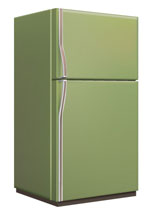Refrigerators and freezers can be some of the biggest energy hogs in your home. They draw electricity around the clock, not just when the kids leave the door open – as much as 18% of your energy costs each year. And we often forget to clean the mechanical parts, making the compressor and radiator work harder with each passing year. Energy efficient refrigerators don’t need to be brand new. We have tips on how to get the best performance out of what you already have.

Got one that looks like this? It may still be running, but it’s costing you much more than it should. According to Efficiency Vermont’s home appliance energy usage infographic, a 20 year old, 22 cubic foot refrigerator draws 1,475 kWh per year, costing you $236.
Have a slightly newer fridge? A 10 year old, 22 cubic foot model will draw about half the electricity, 857 kWh, and save you $100 per year on your bill. Brand new models offer even more savings: 537 kWh per year and an annual cost to operate of just $86!
But even if you’re not in the market for a new energy efficient refrigerator you can take a few steps to improve your kitchen energy efficiency.
Keep it clean.
Dust and grease can build up on the back of the refrigerator, making it more difficult for air to vent from the mechanicals and circulate around the unit. Wipe the exterior surfaces down when you clean your other appliances, and use a can of compressed air to remove dust if needed.
Keep it cool.
Your refrigerator’s job is to keep things cool, but we often place them next to the oven, or in direct sunlight. Any heat source will make the fridge work harder. Giving a little extra time to planning your kitchen can make your fridge’s life – and your own – easier.

Keep it closed.
We all know not to leave the refrigerator or freezer doors open, but even closed doors can let cold air out and warm air in. There’s a simple test to check how tightly your refrigerator doors are sealing: open the door and put a piece of paper inside. Now close the door. If you can pull the paper out easily, the door is not tightly sealed.
Fill ‘er up?
Keep it full, but not too full. Refrigerators are designed to use the food and drink inside them to help maintain an even temperature. An empty freezer or fridge will work harder to keep itself cool. But air need to circulate through the inside, so don’t fill it up all the way.
You don’t have to invest in new energy efficient refrigerators to save money on your home energy bills. A few simple changes to the way you use your appliances can make a big difference.
If you are in the market for a new fridge or freezer, be sure to consider an Energy Star rated model. Energy Star rated refrigerators and freezers are certified to use less electricity and save you money every month, and every year, you own them.
